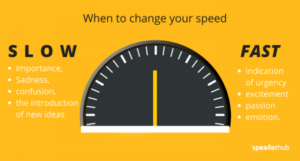The Preacher’s Voice Is A Great Tool
The Preacher’s Voice is a Great Tool
In the last post we considered some of the ways a preacher’s voice can be a disadvantage in communicating the Word of God. In this post we turn to the fact that the preacher’s voice is a great tool for effective communication.
Pace of Preaching
As we saw in the last post, a preaching pace that is either too fast or too slow, too loud or too soft, can be a drawback to communication. Either people will not be able to understand the message, or they will tune out because they are bored by the presentation. A big question, then, is: what is the best pace for preaching? Should you speak faster; or slower? Or maybe the goal is to shoot for a medium pace?
Variety In Voice Is A Great Tool

Brandon Hilgemann
I’ve indicated before in the last several posts, that I am dependent on a little book called Preach and Deliver by Brandon Hilgemann for many of these reflections, and that is true here. Hilgemann says that, “You need to have variety in your sermon. If you preach at the same pace for the entire sermon, your audience will lose focus. Your speaking will become white noise, no matter how fast or how slow it is.”
An Example
 For instance, think about the last time you saw a drug commercial on television. As the commercial comes to a close the people in the picture are smiling, doing something fun. In the meantime, the narrator is reading a list of all the possible complications of the drug, from stomach upset to blood pressure problems, and even to death. But because the voice is a monotone, and the pace is not varied, you don’t focus on those terrible things that could happen. You will focus on the smiling voices on the screen. The voice in the background becomes white noise. That’s exactly what the advertisers want.
For instance, think about the last time you saw a drug commercial on television. As the commercial comes to a close the people in the picture are smiling, doing something fun. In the meantime, the narrator is reading a list of all the possible complications of the drug, from stomach upset to blood pressure problems, and even to death. But because the voice is a monotone, and the pace is not varied, you don’t focus on those terrible things that could happen. You will focus on the smiling voices on the screen. The voice in the background becomes white noise. That’s exactly what the advertisers want.
That’s what can happen if you don’t vary your pace in your sermon. It becomes background noise. But, if you vary your pace, the preacher’s voice is a great tool that will help people connect with your message.
The Variety Described
When you think of pace, think in terms of three different styles of speaking.
Regular Pace:Your regular preaching voice will be used during most of your message. It is often compared to a conversational kind of speaking. Picture the pace of your speech when you are having a one-on-one conversation with someone. That pace is usually not too fast or too slow–unless you get excited about something. Think of that pace, and now picture going just a little faster than that. Andy Stanley, pastor, author, consultant, says in his book, Communicating for Change, that our average, regular pace, should be slightly faster than our normal conversational pace. Here’s what this means technically: English speakers have an average pace of 150 words per minute; a faster speaker will speak at 190 words per minute; a slower speaker will speak around 130 words per minute. So aim for around 140 to 160 words per minute for your normal pace in preaching.
Excited Pace: When you want to communicate excitement or passion, speed up. I heard a preacher yesterday who did this  well. He was talking about the vision process that the church was involved with at the time. As he talked about being the presence of Jesus in the community, and the glory of having God working through people, he picked up his pace. He was excited, and his excitement was contagious. The preacher’s voice is a great tool when you speak a little bit faster and a little bit louder.
well. He was talking about the vision process that the church was involved with at the time. As he talked about being the presence of Jesus in the community, and the glory of having God working through people, he picked up his pace. He was excited, and his excitement was contagious. The preacher’s voice is a great tool when you speak a little bit faster and a little bit louder.
Slow Pace: When you really want to make an emphasis, slow down. When you go fast and then suddenly slow down, the audience perks up. You have communicated to them that what you are saying now is really important. When you are talking about serious stuff, slow down. You will see your congregation tune in.
Next time we’ll continue talking about pace. In the meantime, here is another speech coach giving reflections on how to get to the right pace of speech.



